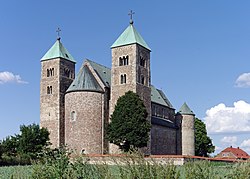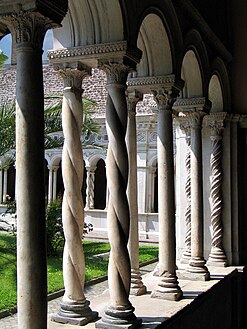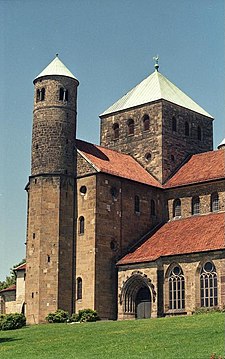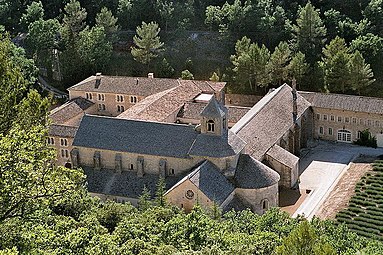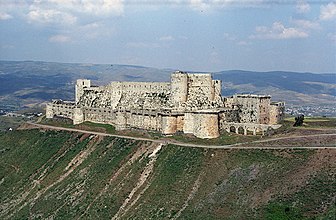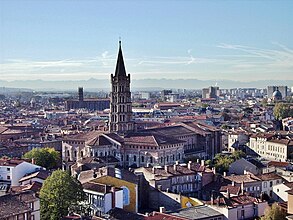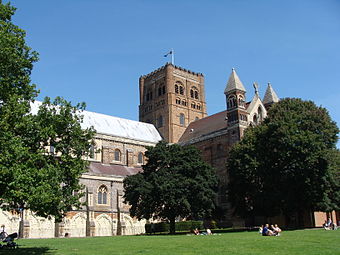
A | B | C | D | E | F | G | H | CH | I | J | K | L | M | N | O | P | Q | R | S | T | U | V | W | X | Y | Z | 0 | 1 | 2 | 3 | 4 | 5 | 6 | 7 | 8 | 9
Top: Lessay Abbey in Normandy (France); Middle: Collegiate Church in Tum (Poland); Bottom: Maria Laach Abbey (Germany) | |
| Years active | 10th to 13th century |
|---|---|
| Location | Catholic Europe |
Romanesque architecture is an architectural style of medieval Europe that was predominant in the 11th and 12th centuries.[1] The style eventually developed into the Gothic style with the shape of the arches providing a simple distinction: the Romanesque is characterized by semicircular arches, while the Gothic is marked by the pointed arches. The Romanesque emerged nearly simultaneously in multiple countries (France, Germany, Italy, Spain);[1] its examples can be found across the continent, making it the first pan-European architectural style since Imperial Roman architecture. Similarly to Gothic, the name of the style was transferred onto the contemporary Romanesque art.[1]
Combining features of ancient Roman and Byzantine buildings and other local traditions, Romanesque architecture is known by its massive quality, thick walls, round arches, sturdy pillars, barrel vaults, large towers and decorative arcading. Each building has clearly defined forms, frequently of very regular, symmetrical plan. The overall appearance is one of simplicity when compared with the Gothic buildings that were to follow. The style can be identified right across Europe, despite regional characteristics and different materials.
Many castles were built during this period, but they are greatly outnumbered by churches. The most significant are the great abbey churches, many of which are still standing, more or less complete and frequently in use.[2] The enormous quantity of churches built in the Romanesque period was succeeded by the still busier period of Gothic architecture, which partly or entirely rebuilt most Romanesque churches in prosperous areas like England and Portugal. The largest groups of Romanesque survivors are in areas that were less prosperous in subsequent periods, including parts of southern France, rural Spain and rural Italy. Survivals of unfortified Romanesque secular houses and palaces, and the domestic quarters of monasteries are far rarer, but these used and adapted the features found in church buildings, on a domestic scale.
Definition
The French term "romane" or the English Romanesque, meaning "in the manner of Romans",[3] has been used to describe the architectural style of the Mediaeval era, preceding the more easily recognizable Gothic architecture, since early in the 19th century.[4] It describes the architectural style which flourished across Europe from the 11th to the 13th century, and is distinguished from the Gothic style that followed by semi-circular arches and more massive forms. The development of vaults from barrel and groin vaults to ribbed vaults was the main structural innovation of this period.[5]
- Typical Romanesque architectural forms
-
Portal, Church of Santa Maria, Viu de Llevata, Catalonia, Spain
-
The vault at the Abbey Church of Sainte-Foy, Conques, France
-
Cloister of the Basilica di San Giovanni in Laterano, Rome
-
Bell tower of Angoulême Cathedral, Charente, SW France
-
Window and Lombard band of the Rotunda of San Tomè, Almenno San Bartolomeo
Use of the term Romanesque

The distinction between the style of architecture now known as Romanesque, and the succeeding style of Gothic architecture was recognised as early as the 15th century, as demonstrated by some artworks of that period. Robert Campin clearly presented the division in his Marriage of the Virgin; on the left side, representing the Old Testament, the building is in the Romanesque style, while that on the right, representing the New Testament, is Gothic. Until the 19th century, however, the style preceding Gothic was not recognized as a whole, and was instead, just like Gothic at the time, treated as a multitude of styles: Giorgio Vasari and Christopher Wren were writing about "Tuscan", "Saxon", or "Norman" architectures.[6][7]
The word Romanesque ("in the manner of Romans"[3]) appeared in English by 1666, and was used to designate what are now called Romance languages.[8] Definition of Romanesque architecture changed over time;[4] the development of the modern English meaning of the word involved primarily two steps:
- in 1813 William Gunn used the term to broadly describe the pre-Gothic architecture of the Western Europe, all the way from the 4th century to the 12th.[4] Gunn's work, An Inquiry into the Origin and Influence of Gothic Architecture (London 1819), was published later,[9] in 1819.[10][11] The word was used by Gunn to describe the style that was identifiably Medieval and prefigured the Gothic, yet maintained the rounded Roman arch and thus appeared to be a continuation of the Roman tradition of building;
- over the course of the 19th century and the first half of the 20th century[12] the definition narrowed to a shorter period, typically from 11th (or late 10th[6]) to 12th century.[4] In the process, scholars (with notable contributions by Robert de Lasteyrie and Henri Focillon) changed the original definition of Romanesque as a sub-Roman or Roman-like architecture to a stylistic label describing the arrangements of mass and space that found acceptance at the turn of the 11th century. The new definition also marks the watershed between the tribal/dynastic treatment of architectural styles (Egyptian, Greek, Roman, Merovingian, Carolingian, etc.) and a feature-based one (Gothic, Renaissance, Mannerist, Baroque).[6]
The French term "romane" was first used in the architectural sense by archaeologist Charles de Gerville in a letter of 18 December 1818 to Auguste Le Prévost to describe what Gerville sees as a debased Roman architecture.[Notes 1][14] In an 1823 public lecture (published in 1824)[9] Gerville's friend Arcisse de Caumont adopted the label "roman" to describe the "degraded" European architecture from the 5th to the 13th centuries, in his Essai sur l'architecture religieuse du moyen-âge, particulièrement en Normandie,[15] at a time when the actual dates of many of the buildings so described had not been ascertained:[16][17][18]
"The name Roman (esque) we give to this architecture, which should be universal as it is the same everywhere with slight local differences, also has the merit of indicating its origin and is not new since it is used already to describe the language of the same period. Romance language is degenerated Latin language. Romanesque architecture is debased Roman architecture."[Notes 2]
The term "Pre-romanesque" is sometimes applied to architecture in Germany of the Carolingian and Ottonian periods and Visigothic, Mozarab and Asturian constructions between the 8th and the 10th centuries in the Iberian Peninsula while "First Romanesque" is applied to buildings in north of Italy and Spain and parts of France that have Romanesque features but pre-date the influence of the Abbey of Cluny. The Romanesque style in England and Sicily is still referred to as Norman architecture. A "dazzling"[20] style developed in Pisa in the mid-11th century is called "Pisan Romanesque".[21]
Eric Fernie writes that by the beginning of the 21st century there is "something like agreement" on the characteristics of the Romanesque style.[22] Some researchers argue that due to an "astonishing diversity" of the Romanesque buildings, a unanimous definition is impossible: "o single model, no single rule, ever seems adequate to prevail",[23] and the Romanesque should be treated as a "collection of trends".[3] Despite disagreement, the term became a "common currency", and is universally accepted at least for convenience.[23]
Scope
Buildings of every type were constructed in the Romanesque style, with evidence remaining of simple domestic buildings, elegant town houses, grand palaces, commercial premises, civic buildings, castles, city walls, bridges, village churches, abbey churches, abbey complexes and large cathedrals.[24] Of these types of buildings, domestic and commercial buildings are the most rare, with only a handful of survivors in the United Kingdom, several clusters in France, isolated buildings across Europe and by far the largest number, often unidentified and altered over the centuries, in Italy. Many castles exist, the foundations of which date from the Romanesque period. Most have been substantially altered, and many are in ruins.
By far the greatest number of surviving Romanesque buildings are churches. These range from tiny chapels to large cathedrals. Although many have been extended and altered in different styles, a large number remain either substantially intact or sympathetically restored, demonstrating the form, character and decoration of Romanesque church architecture.[24]
- The scope of Romanesque architecture
-
Saint Nicholas Rotunda in Cieszyn, Poland
-
Romanesque house in Poreč, Croatia
-
The Civic Hall in Massa Marittima, Italy
-
Abbey Church of St James, Lébény, Hungary (1208)
-
The keep of Conisbrough Castle, England
History
Origins
Romanesque architecture was the first distinctive style to spread across Europe since the Roman Empire. With the decline of Rome, Roman building methods survived to an extent in Western Europe, where successive Merovingian, Carolingian and Ottonian architects continued to build large stone buildings such as monastery churches and palaces. In the more northern countries, Roman building styles and techniques had never been adopted except for official buildings, while in Scandinavia they were unknown. Although the round arch continued in use, the engineering skills required to vault large spaces and build large domes were lost. There was a loss of stylistic continuity, particularly apparent in the decline of the formal vocabulary of the Classical Orders. In Rome several great Constantinian basilicas continued in use as an inspiration to later builders. Some traditions of Roman architecture also survived in Byzantine architecture with the 6th-century octagonal Byzantine Basilica of San Vitale in Ravenna being the inspiration for the greatest building of the Early Middle Ages in Europe, the Emperor Charlemagne's Palatine Chapel, Aachen, Germany, built around the year AD 800.[25]
Dating shortly after the Palatine Chapel is a remarkable 9th-century Swiss manuscript known as the Plan of Saint Gall and showing a very detailed plan of a monastic complex, with all its various monastic buildings and their functions labelled. The largest building is the church, the plan of which is distinctly Germanic, having an apse at both ends, an arrangement not generally seen elsewhere. Another feature of the church is its regular proportion, the square plan of the crossing tower providing a module for the rest of the plan. These features can both be seen at the Proto-Romanesque St. Michael's Church, Hildesheim, 1001–1030.[25]
Architecture of a Romanesque style also developed simultaneously in the north of Italy, parts of France and in the Iberian Peninsula in the 10th century and prior to the later influence of the Abbey of Cluny. The style, sometimes called First Romanesque or Lombard Romanesque, is characterised by thick walls, lack of sculpture and the presence of rhythmic ornamental arches known as a Lombard band.
- Origins
-
Santa Maria in Cosmedin, Rome (8th – early 12th century) has a basilical plan and reuses ancient Roman columns.
-
Charlemagne's Palatine Chapel, Aachen, Germany, 9th century, modelled on the Byzantine church of San Vitale, Ravenna
-
Interior of St. Michael's, Hildesheim, Germany, (1001–1031) with alternating piers and columns and a 13th-century painted wooden ceiling
-
St. Michael's Church, Hildesheim has similar characteristics to the church in the Plan of Saint Gall.
Politics
Charlemagne was crowned by Pope Leo III in Old St. Peter's Basilica on Christmas Day of 800, with an aim to re-establishing the old Roman Empire. Charlemagne's political successors continued to rule much of Europe, with a gradual emergence of the separate political states that were eventually to become welded into nations, either by allegiance or defeat, into the Kingdom of Germany giving rise to the Holy Roman Empire. The invasion of England by William, Duke of Normandy, in 1066, saw the building of both castles and churches that reinforced the Norman presence. Several significant churches that were built at this time were founded by rulers as seats of temporal and religious power, or places of coronation and burial. These include the Abbaye-Saint-Denis, Speyer Cathedral and Westminster Abbey (where little of the Pre-Conquest church now remains).
At a time when the remaining architectural structures of the Roman Empire were falling into decay and much of its learning and technology lost, the building of masonry domes and the carving of decorative architectural details continued unabated, though greatly evolved in style since the fall of Rome, in the enduring Byzantine Empire. The domed churches of Constantinople and Eastern Europe were to greatly affect the architecture of certain towns, particularly through trade and through the Crusades. The most notable single building that demonstrates this is St Mark's Basilica, Venice, but there are many lesser-known examples, particularly in France, such as the church of Saint-Front, Périgueux and Angoulême Cathedral.[26]
Much of Europe was affected by feudalism in which peasants held tenure from local rulers over the land that they farmed in exchange for military service. The result of this was that they could be called upon, not only for local and regional spats, but to follow their lord to travel across Europe to the Crusades, if they were required to do so. The Crusades, 1095–1270, brought about a very large movement of people and, with them, ideas and trade skills, particularly those involved in the building of fortifications and the metal working needed for the provision of arms, which was also applied to the fitting and decoration of buildings. The continual movement of people, rulers, nobles, bishops, abbots, craftsmen and peasants, was an important factor in creating a homogeneity in building methods and a recognizable Romanesque style, despite regional differences.
Life became generally less secure after the Carolingian period. This resulted in the building of castles at strategic points, many of them being constructed as strongholds of the Normans, descendants of the Vikings who invaded northern France under Rollo in 911. Political struggles also resulted in the fortification of many towns, or the rebuilding and strengthening of walls that remained from the Roman period. One of the most notable surviving fortifications is that of the city of Carcassonne. The enclosure of towns brought about a lack of living space within the walls, and resulted in a style of town house that was tall and narrow, often surrounding communal courtyards, as at San Gimignano in Tuscany and Bologna and Pavia in Lombardy.[27][28][29]
In Germany, the Holy Roman Emperors built a number of residences, fortified, but essentially palaces rather than castles, at strategic points and on trade routes. The Imperial Palace of Goslar (heavily restored in the 19th century) was built in the early 11th century by Otto III and Henry III, while the ruined Palace at Gelnhausen was received by Frederick Barbarossa prior to 1170.[30] The movement of people and armies also brought about the building of bridges, some of which have survived, including the 12th-century bridge at Besalú, Catalonia, the 11th-century Puente de la Reina, Navarre and the Pont-Saint-Bénézet, Avignon.[31]
- Politics
-
The Tower of London (1078); William the Conqueror built the central White Tower as his stronghold and residence
-
Speyer Cathedral, Germany, begun by Conrad II, Holy Roman Emperor in 1030, as an expression of imperial power and architectural innovation
-
Many towns, such as San Gimignano, were enclosed with walls, causing crowding and the building of tower houses
Religion
Across Europe, the late 11th and 12th centuries saw an unprecedented growth in the number of churches.[32] A great number of these buildings, both large and small, remain, some almost intact and in others altered almost beyond recognition in later centuries. They include many very well known churches such as Santa Maria in Cosmedin in Rome,[33] the Baptistery in Florence[34] and San Zeno Maggiore in Verona.[35] In France, the famous abbeys of Aux Dames and Les Hommes at Caen and Mont Saint-Michel date from this period, as well as the abbeys of the pilgrimage route to Santiago de Compostela. Many cathedrals owe their foundation to this date, with others beginning as abbey churches, and later becoming cathedrals. In England, of the cathedrals of ancient foundation, all were begun in this period with the exception of Salisbury, where the monks relocated from the Norman church at Old Sarum, and several, such as Canterbury, which were rebuilt on the site of Saxon churches.[36][37] In Spain, the most famous church of the period is Santiago de Compostela. In Germany, the Rhine and its tributaries were the location of many Romanesque abbeys, notably Mainz, Worms, Speyer and Bamberg. In Cologne, then the largest city north of the Alps, a very important group of large city churches survived largely intact. As monasticism spread across Europe, Romanesque churches sprang up in Scotland, Scandinavia, Poland, Hungary, Sicily, Serbia and Tunisia. Several important Romanesque churches were built in the Crusader kingdoms.[38][39]
Monasticism
The system of monasticism in which the religious become members of an order, with common ties and a common rule, living in a mutually dependent community, rather than as a group of hermits living in proximity but essentially separate, was established by the monk Benedict in the 6th century. The Benedictine monasteries spread from Italy throughout Europe, being always by far the most numerous in England. They were followed by the Cluniac order, the Cistercians, Carthusians and Augustinian Canons. During the Crusades, the military orders of the Knights Hospitaller and the Knights Templar were founded.
The monasteries, which sometimes also functioned as cathedrals, and the cathedrals that had bodies of secular clergy often living in community, were a major source of power in Europe. Bishops and the abbots of important monasteries lived and functioned like princes. The monasteries were the major seats of learning of all sorts. Benedict had ordered that all the arts were to be taught and practiced in the monasteries. Within the monasteries books were transcribed by hand, and few people outside the monasteries could read or write.[2]
In France, Burgundy was the centre of monasticism. The enormous and powerful monastery at Cluny was to have lasting effect on the layout of other monasteries and the design of their churches. Very little of the abbey church at Cluny remains; the "Cluny II" rebuilding of 963 onwards has completely vanished, but we have a good idea of the design of "Cluny III" from 1088 to 1130, which until the Renaissance remained the largest building in Europe. However, the church of St. Sernin at Toulouse, 1080–1120, has remained intact and demonstrates the regularity of Romanesque design with its modular form, its massive appearance and the repetition of the simple arched window motif.[25]
- Types of churches
-
Many parish churches across Europe, such as this in Vestre Slidre, Norway, are of Romanesque foundation.
-
The Romanesque Sénanque Abbey church and surrounding monastic buildings, Gordes, Provence, France
-
Collegiate churches such as that of Saint Hadelin, Celles, Belgium, were administered by lay canons.
-
Many cathedrals such as Trier Cathedral, Germany, date from this period, with many later additions.
Pilgrimage and Crusade
One of the effects of the Crusades, which were intended to wrest the Holy Places of the Levant from Islamic control, was to excite a great deal of religious fervour, which in turn inspired great building programs. The Nobility of Europe, upon safe return, thanked God by the building of a new church or the enhancement of an old one. Likewise, those who did not return from the Crusades could be suitably commemorated by their family in a work of stone and mortar.
The Crusades resulted in the transfer of, among other things, a great number of Holy Relics of saints and apostles. Many churches, like Saint-Front, Périgueux, had their own home grown saint while others, most notably Santiago de Compostela, claimed the remains and the patronage of a powerful saint, in this case one of the Twelve Apostles. Santiago de Compostela, located in the Kingdom of Galicia (present day Galicia, Spain) became one of the most important pilgrimage destinations in Europe. Most of the pilgrims travelled the Way of St. James on foot, many of them barefooted as a sign of penance. They moved along one of the four main routes that passed through France, congregating for the journey at Jumièges, Paris, Vézelay, Cluny, Arles and St. Gall in Switzerland. They crossed two passes in the Pyrenees and converged into a single stream to traverse north-western Spain. Along the route they were urged on by those pilgrims returning from the journey. On each of the routes abbeys such as those at Moissac, Toulouse, Roncesvalles, Conques, Limoges and Burgos catered for the flow of people and grew wealthy from the passing trade. Saint-Benoît-du-Sault, in the Berry province, is typical of the churches that were founded on the pilgrim route.[2][25]
- Pilgrimage and crusade
-
The Church of the Holy Sepulchre, Jerusalem, a major pilgrimage site from the 4th century onwards. Its rotunda inspired the construction of many Romanesque circular churches.
-
Like many castles built by crusader knights, the inner fortress of Krak des Chevaliers, Syria, was mainly constructed in this period, with the outer walls being later.
-
The Abbey of Saint Foy, Conques, France, was one of many such abbeys to be built along the pilgrimage Way of St James that led to Santiago de Compostela.
-
The plan of the Church of Saint Front, Périgueux, France, was influenced by Byzantine architecture seen by the Crusaders. The present appearance is largely due to restorer Paul Abadie, mid-19th century.
-
The basilica of Saint-Sernin in Toulouse is the archetype of large pilgrimage churches, where pilgrims could walk around the church via the transept and the choir chapels.
Characteristics
The general impression given by Romanesque architecture, in both ecclesiastical and secular buildings, is one of massive solidity and strength. In contrast with both the preceding Roman and later Gothic architecture, in which the load-bearing structural members are, or appear to be, columns, pilasters and arches, Romanesque architecture, in common with Byzantine architecture, relies upon its walls, or sections of walls called piers.[2]
Romanesque architecture is often divided into two periods known as the "First Romanesque" style and the "Romanesque" style. The difference is chiefly a matter of the expertise with which the buildings were constructed. The First Romanesque employed rubble walls, smaller windows and unvaulted roofs. A greater refinement marks the Second Romanesque, along with increased use of the vault and dressed stone.
Walls
The walls of Romanesque buildings are often of massive thickness with few and comparatively small openings. They are often double shells, filled with rubble.
The building material differs greatly across Europe, depending upon the local stone and building traditions. In Italy, Poland, much of Germany and parts of the Netherlands, brick is generally used. Other areas saw extensive use of limestone, granite and flint. The building stone was often used in comparatively small and irregular pieces, bedded in thick mortar. Smooth ashlar masonry was not a distinguishing feature of the style (especially not in the earlier part of the period), but it did occur, chiefly where easily worked limestone was available.[40]
Buttresses
Because of the massive nature of Romanesque walls, buttresses are not a highly significant feature, as they are in Gothic architecture. Romanesque buttresses are generally of flat square profile and do not project a great deal beyond the wall. In the case of aisled churches, barrel vaults, or half-barrel vaults over the aisles helped to buttress the nave, if it was vaulted.
In the cases where half-barrel vaults were used, they effectively became like flying buttresses. Often aisles extended through two storeys, rather than the one usual in Gothic architecture, so as to better support the weight of a vaulted nave. In the case of Durham Cathedral, flying buttresses have been employed, but are hidden inside the triforium gallery.[37]
- Walls and buttresses
-
The monastery of San Vittore alle Chiuse, Genga, Italy, of undressed stone, has a typically fortress-like appearance with small windows of early Romanesque.
-
Castle Rising Castle, England, shows flat buttresses and reinforcing at the corners of the building typical in both castles and churches.
-
Cerisy Abbey, Normandy, France, has a compact appearance with aisles rising through two storeys buttressing the vault.
-
St Albans Cathedral England, demonstrates the typical alterations made to the fabric of many Romanesque buildings in different styles and materials
Arches and openings
The arches used in Romanesque architecture are nearly always semicircular, for openings such as doors and windows, for vaults and for arcades. Wide doorways are usually surmounted by a semi-circular arch, except where a door with a lintel is set into a large arched recess and surmounted by a semi-circular "lunette" with decorative carving.[25] These doors sometimes have a carved central jamb.
Narrow doors and small windows might be surmounted by a solid stone lintel. Larger openings are nearly always arched. A characteristic feature of Romanesque architecture, both ecclesiastic and domestic, is the pairing of two arched windows or arcade openings, separated by a pillar or colonette and often set within a larger arch. Ocular windows are common in Italy, particularly in the façade gable and are also seen in Germany. Later Romanesque churches may have wheel windows or rose windows with plate tracery.
There are a very small number of buildings in the Romanesque style, such as Autun Cathedral in France and Monreale Cathedral in Sicily in which pointed arches have been used extensively, apparently for stylistic reasons. It is believed that in these cases there is a direct imitation of Islamic architecture. At other late Romanesque churches such as Durham Cathedral, and Cefalù Cathedral, the pointed arch was introduced as a structural device in ribbed vaulting. Its increasing application was fundamental to the development of Gothic architecture.
Zdroj:https://en.wikipedia.org?pojem=Romanesque_Architecture
Text je dostupný za podmienok Creative Commons Attribution/Share-Alike License 3.0 Unported; prípadne za ďalších podmienok. Podrobnejšie informácie nájdete na stránke Podmienky použitia.
Antropológia
Aplikované vedy
Bibliometria
Dejiny vedy
Encyklopédie
Filozofia vedy
Forenzné vedy
Humanitné vedy
Knižničná veda
Kryogenika
Kryptológia
Kulturológia
Literárna veda
Medzidisciplinárne oblasti
Metódy kvantitatívnej analýzy
Metavedy
Metodika
Text je dostupný za podmienok Creative
Commons Attribution/Share-Alike License 3.0 Unported; prípadne za ďalších
podmienok.
Podrobnejšie informácie nájdete na stránke Podmienky
použitia.
www.astronomia.sk | www.biologia.sk | www.botanika.sk | www.dejiny.sk | www.economy.sk | www.elektrotechnika.sk | www.estetika.sk | www.farmakologia.sk | www.filozofia.sk | Fyzika | www.futurologia.sk | www.genetika.sk | www.chemia.sk | www.lingvistika.sk | www.politologia.sk | www.psychologia.sk | www.sexuologia.sk | www.sociologia.sk | www.veda.sk I www.zoologia.sk


